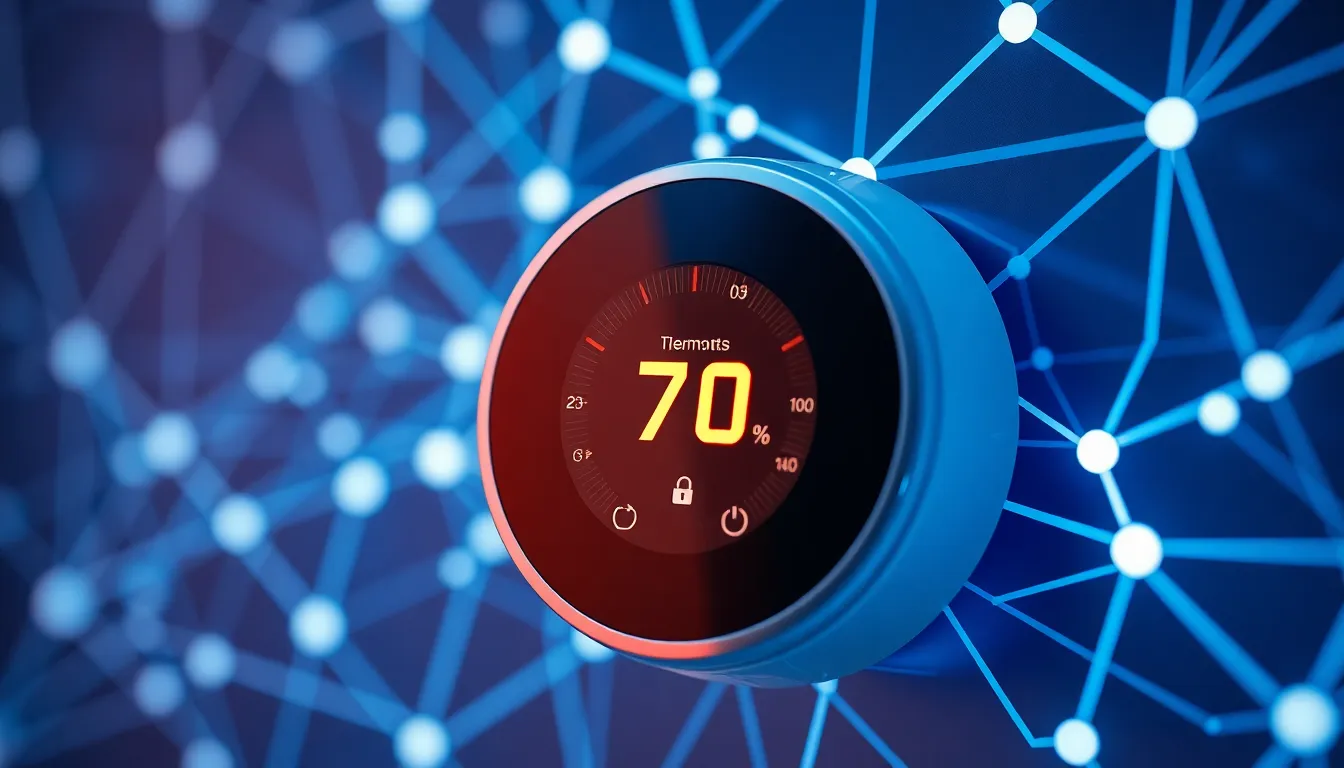Table of Contents
ToggleIn a world where your toaster can tweet and your fridge knows your shopping habits, the Internet of Things (IoT) is revolutionizing everyday life. But while these smart devices make life easier, they also open the door to a whole new realm of cybersecurity threats. Imagine your smart thermostat deciding to crank the heat up to 90 degrees while you’re on vacation—yikes!
Overview of Internet of Things Cybersecurity
Internet of Things cybersecurity encompasses strategies, technologies, and practices that protect connected devices and networks from cyber threats. Significant threats include unauthorized access, data breaches, and device manipulation. Each device connected to the internet poses a potential vulnerability, emphasizing the need for robust security measures.
Smart home devices, including cameras, locks, and thermostats, often lack comprehensive security features. Weak passwords or default settings frequently leave these devices exposed. Manufacturers increasingly prioritize security in their designs, integrating encryption and secure boot processes to enhance protection.
Attackers typically exploit vulnerabilities in IoT devices to gain access to home networks. Malware, for example, can spread through poorly secured devices, allowing intruders to launch attacks on other network-connected equipment. Reports indicate that IoT-related attacks increased by over 100 percent in 2022 alone, underscoring the urgency of addressing these risks.
Security frameworks, such as the NIST Cybersecurity Framework, provide guidelines for organizations to follow when protecting IoT systems. Following these protocols can mitigate risks and enhance overall security postures. Regular software updates, for example, patch known vulnerabilities and protect devices against the latest threats.
Users can take proactive steps to secure their own devices. Changing default passwords, disabling unnecessary features, and regularly reviewing connected devices helps reduce exposure. Developing a security-conscious mindset ensures both individual and collective safety in an increasingly connected world.
Key Threats to IoT Security

The Internet of Things (IoT) faces several significant cybersecurity threats. Understanding these threats helps in developing better protective measures.
Malware Attacks
Malware attacks pose a serious risk to IoT devices. This type of malicious software targets vulnerable devices, often exploiting outdated firmware or software. Ransomware, specifically, holds devices hostage for payment, impacting user access and privacy. A large surge in these attacks is evident, with reports indicating a 50% increase in IoT-specific malware incidents in recent years. Many attackers use IoT devices as entry points to larger networks. They often infiltrate home routers or connected cameras. Recognizing the potential impact of such malware is crucial for both users and manufacturers.
Device Vulnerabilities
Device vulnerabilities originate from various sources. Many IoT devices lack necessary security features, leading to increased risks. Weak authentication methods, such as default passwords, remain common, making unauthorized access easy for attackers. Research indicates that over 70% of popular IoT devices have security flaws. Insufficient encryption of sensitive data further exacerbates these issues. Security updates are frequently neglected, leaving devices exposed. Addressing these vulnerabilities involves both manufacturers implementing stronger security protocols and users actively managing their devices. Prioritizing device security helps mitigate potential threats in the interconnected landscape.
Best Practices for Securing IoT Devices
Securing IoT devices requires a proactive approach to protect against cyber threats. Implementing strong security measures is essential at every level of device management.
Strong Authentication Methods
Using strong authentication methods is vital for ensuring device security. Multi-factor authentication enhances protection by requiring additional verification steps. Passwords should be complex, incorporating numbers, symbols, and a mix of upper and lower case letters. Always change default passwords, as they are often easy targets for attackers. Employing biometric authentication, when available, adds an extra layer of security. Devices lacking robust authentication features are particularly susceptible to unauthorized access. The adoption of these practices significantly decreases the likelihood of hacking incidents and data breaches.
Regular Software Updates
Regular software updates play a crucial role in maintaining IoT security. Outdated firmware can contain vulnerabilities that are easily exploited by cybercriminals. Users must monitor and install updates promptly to minimize risks. Additionally, automated updates can help ensure that devices remain secure without requiring manual intervention. Manufacturers should provide clear communication about available updates to facilitate timely action. Security patches often address critical issues and strengthen overall device integrity. Keeping devices updated protects against emerging threats and safeguards user data effectively.
Emerging Trends in IoT Cybersecurity
Adoption of artificial intelligence (AI) in IoT cybersecurity is gaining momentum. AI enhances threat detection capabilities, analyzing vast data streams to identify suspicious activities in real-time. Implementation of machine learning algorithms improves responses to emerging threats, adapting to new attack patterns swiftly.
Increased focus on privacy regulations drives better security practices. Governments are enacting stricter regulations, mandating higher security standards for IoT devices. Compliance with these regulations helps manufacturers prioritize user data protection, fostering consumer trust in smart devices.
Development of zero-trust security models is another notable trend. Zero-trust frameworks operate on the principle that no device should be trusted by default, requiring continuous verification before granting access. Organizations embracing this model effectively minimize potential attack surfaces, reducing vulnerabilities.
Growing popularity of blockchain technology offers promising solutions for IoT security. Blockchain provides a decentralized and immutable ledger, enhancing data integrity and authenticity. Use of blockchain can help secure IoT ecosystems by enabling transparent device-to-device communication and transactions.
Vendor collaboration is becoming essential in IoT cybersecurity efforts. Companies increasingly work together to share threat intelligence and best practices. Such collaboration strengthens defenses against common threats, addressing vulnerabilities more effectively across the industry.
Adoption of behavioral analytics also plays a crucial role in IoT security. Monitoring user behavior patterns allows for quicker identification of anomalies that may indicate potential threats. This proactive approach ensures that unusual activities are detected and addressed without delay.
Overall, these emerging trends shape the landscape of IoT cybersecurity, highlighting the necessity of comprehensive protective measures in an expanding digital environment.
Regulatory Landscape and Standards
Regulatory frameworks play a crucial role in shaping IoT cybersecurity practices. Various organizations establish standards to guide manufacturers and users in securing their devices. The National Institute of Standards and Technology (NIST) Cybersecurity Framework offers guidelines for organizations seeking to enhance their IoT security posture. Compliance with these guidelines helps organizations address common threats, including those posed by outdated firmware and weak authentication methods.
The European Union’s General Data Protection Regulation (GDPR) sets stringent requirements for data protection, impacting how IoT devices handle personal information. Manufacturers must take care to incorporate privacy by design into their products, ensuring user data remains secure. Various industry-specific regulations, such as the Health Insurance Portability and Accountability Act (HIPAA) for healthcare IoT devices, further emphasize the importance of robust cybersecurity measures.
Standards development organizations, including the International Organization for Standardization (ISO) and the Institute of Electrical and Electronics Engineers (IEEE), actively work on IoT cybersecurity standards. Their efforts focus on establishing benchmarks for device security, communication protocols, and overall ecosystem integrity. Companies implementing these standards benefit from enhanced trust and reputation in the marketplace.
Emerging regulations are also on the horizon, reflecting the rapid evolution of IoT technologies. As the incidence of IoT-related cyber attacks rises, regulators may introduce additional requirements to ensure compliance and reduce risk. Organizations must remain vigilant and adaptive to these changes, prioritizing ongoing staff training and security audits to maintain compliance.
Vulnerabilities in IoT devices demand immediate attention from both users and manufacturers. Governments encourage collaboration across sectors to improve information sharing about threats and effective practices. A cohesive approach to regulation not only strengthens IoT security but also fosters innovation, ensuring the growth of a safer, interconnected digital environment.
The evolving landscape of IoT cybersecurity requires a proactive approach from both manufacturers and users. As smart devices become integral to daily life the risks associated with inadequate security measures cannot be ignored. Implementing robust security protocols and staying informed about emerging threats is essential for protecting personal data and ensuring device integrity.
With the rise of advanced technologies like AI and blockchain the future of IoT security looks promising. However the responsibility lies with everyone involved to foster a culture of security awareness. By prioritizing security practices and adhering to regulatory guidelines individuals and organizations can significantly mitigate risks and enjoy the benefits of a connected world safely.







